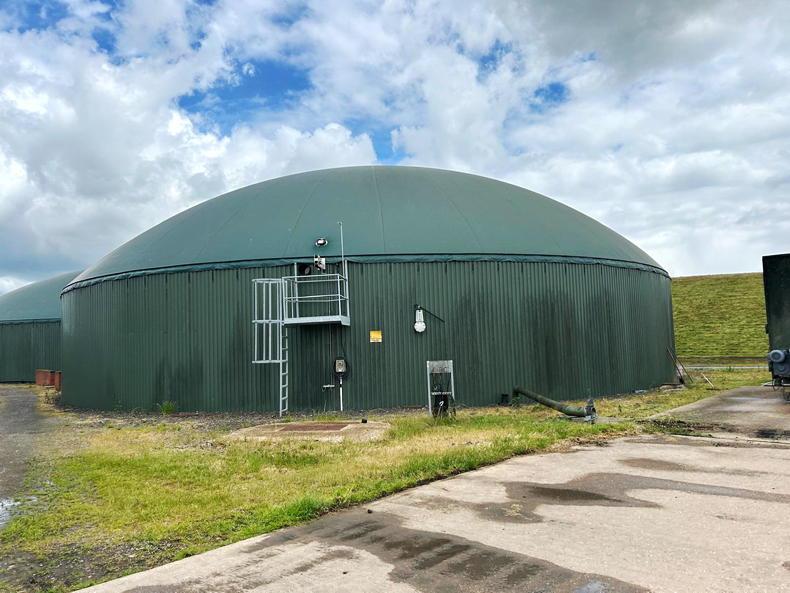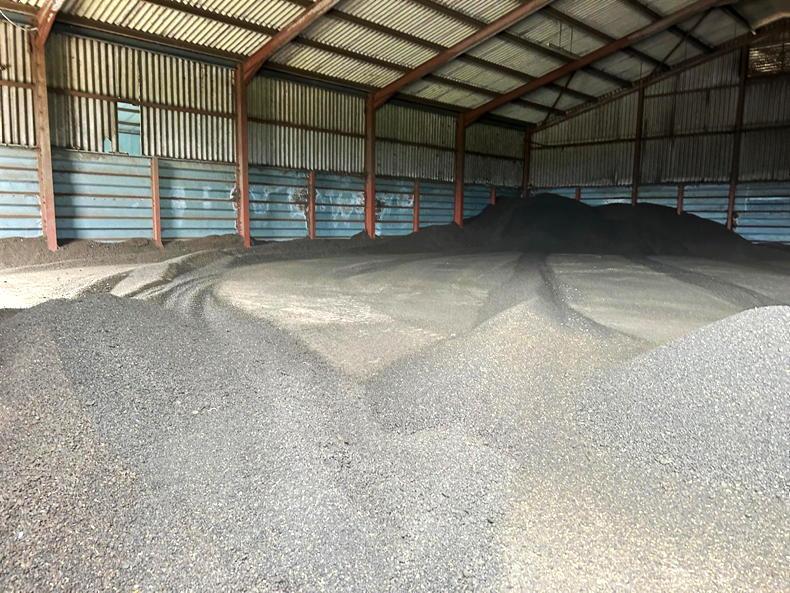Over a decade ago, English farmer Andrew Channing and his brother Alistair decided to pack in their 220-cow dairy enterprise and dip their toes into producing renewable energy.
With a potato growing business on the go as well, the move to invest in an anaerobic digester was a brave one, considering not many farmers in England had yet diversified into this type of business.
Fast forward 10 years, and the Channings’ enterprise is one of the smaller outfits when it comes to producing renewable energy – or, in this case, renewable heat and electricity.
An expensive gas grid connection turned the Channings off producing renewable gas and they decided that selling on electricity only was the way to go.
The farm near Coventry in Warwickshire consists of one 500KW anaerobic digester on a land base of 850 owned acres, alongside some rented land.
Feeding the digester maize only, the Channings grow half of their annual requirement themselves and also buy in maize from other local farms to feed into the digester. Initially, when the Channings began feeding the AD plant, they used grass silage and poultry manure but they have since found maize to be a better feed.
Costing in the region of £2m (€2.37m) to build, the family hope to have the investment paid back within the next two years or so.
“Up to about 15 years ago, we were dairy farmers, we had up to 220 cows,” recalled Andrew Channing.
“Unfortunately, because of economics we packed up and began to look at different options.
“We had a silage clamp available, dirty water storage, so we obviously looked at the option of AD and we came to the decision that we were going to a half megawatt-sized AD plant.
“So in 2013-14, we started to get prices. Then we had to get planning permission. We started building it in 2014 and got going in 2015. Overall, we’ve been very pleased with where it’s gone. We grow about half the maize for the AD plant ourselves. Half is grown on neighbouring farms as a break crop.
“In total we grow about 800ac of maize. We have been selling a bit of maize as well as we had a bit of surplus this year. We’ve also got some biogas boilers – we dry the digestate and it basically produces a granular fertiliser,” Andrew said.
Getting going
The three main steps in setting up the AD plant included shopping around different technology providers that build AD plants, receive planning consent and a grid connection had to be sorted.
“I don’t know what it’s like in Ireland but one of the hardest things with any renewables in the UK is grid connection – it’s a complete nightmare. Once we got a grid connection and discovered it was feasible to do it, then we had to go through the planning process which is particularly arduous,” he explained.

Before making the move to producing renewable energy, Andrew Channing and his brother milked 220 dairy cows.
“We had to get planning permission by December 2014 to get fixed in for tariffs. Fortunately, we got planning permission on 20 December and then we had to get it built within 12 months which was quite stressful.”
The Feed-in Tariff (FiT) was a UK government scheme that paid homeowners and businesses to generate and export to the grid their own electricity, from renewable or low-carbon sources.

The 500kW anaerobic digester is fed only with maize, around 30-32t per day.
“It was first introduced in 2010 to encourage the use of renewable energy and reduce the UK’s dependence on fossil fuels. The scheme is no longer available in the UK,” said Andrew.
“Basically you just heat up silage to 40°C/41°C – that ferments and gives off methane. It produces around about 53% methane and the rest is about 45% CO2, as well as some other parts.
Feeding the digester, Andrew said, is no different to feeding cattle. Around 30t to 32t of maize is fed into the digester each day and consistency is key.
“The worst thing you could do is go from 20t/day to 40t /day,” he said.
Andrew explained how, initially, no banks were prepared to lend them any money for the investment as they feared that the new technology would not make any money.

The Channings grow 800ac of maize themselves and buy more from neighbours.
After going to around five different banks, eventually their own bank “came up trumps”, Andrew recalled.
“In terms of overall investment, it’s around £2m to £2.5m (€2.36m to €2.95m) for this size plant.
“Initially, we did look at the gas to grid option but that was a £10m to £15m (€11.8m to €17.7m) investment and that was way out of our budget,” Andrew said.

A shed of digestate which is used as fertiliser on the land. The Channings are 100% self-sufficient in fertiliser use.
“This AD plant is quite simple – the engine gives off biogas which produces 50% electricity and 50% heat.
“We pump the majority of the electricity back into the national grid to sell, then the heat we use to dry the waste product digestate, which is then made into fertiliser,” he said.
Over a decade ago, English farmer Andrew Channing and his brother Alistair decided to pack in their 220-cow dairy enterprise and dip their toes into producing renewable energy.
With a potato growing business on the go as well, the move to invest in an anaerobic digester was a brave one, considering not many farmers in England had yet diversified into this type of business.
Fast forward 10 years, and the Channings’ enterprise is one of the smaller outfits when it comes to producing renewable energy – or, in this case, renewable heat and electricity.
An expensive gas grid connection turned the Channings off producing renewable gas and they decided that selling on electricity only was the way to go.
The farm near Coventry in Warwickshire consists of one 500KW anaerobic digester on a land base of 850 owned acres, alongside some rented land.
Feeding the digester maize only, the Channings grow half of their annual requirement themselves and also buy in maize from other local farms to feed into the digester. Initially, when the Channings began feeding the AD plant, they used grass silage and poultry manure but they have since found maize to be a better feed.
Costing in the region of £2m (€2.37m) to build, the family hope to have the investment paid back within the next two years or so.
“Up to about 15 years ago, we were dairy farmers, we had up to 220 cows,” recalled Andrew Channing.
“Unfortunately, because of economics we packed up and began to look at different options.
“We had a silage clamp available, dirty water storage, so we obviously looked at the option of AD and we came to the decision that we were going to a half megawatt-sized AD plant.
“So in 2013-14, we started to get prices. Then we had to get planning permission. We started building it in 2014 and got going in 2015. Overall, we’ve been very pleased with where it’s gone. We grow about half the maize for the AD plant ourselves. Half is grown on neighbouring farms as a break crop.
“In total we grow about 800ac of maize. We have been selling a bit of maize as well as we had a bit of surplus this year. We’ve also got some biogas boilers – we dry the digestate and it basically produces a granular fertiliser,” Andrew said.
Getting going
The three main steps in setting up the AD plant included shopping around different technology providers that build AD plants, receive planning consent and a grid connection had to be sorted.
“I don’t know what it’s like in Ireland but one of the hardest things with any renewables in the UK is grid connection – it’s a complete nightmare. Once we got a grid connection and discovered it was feasible to do it, then we had to go through the planning process which is particularly arduous,” he explained.

Before making the move to producing renewable energy, Andrew Channing and his brother milked 220 dairy cows.
“We had to get planning permission by December 2014 to get fixed in for tariffs. Fortunately, we got planning permission on 20 December and then we had to get it built within 12 months which was quite stressful.”
The Feed-in Tariff (FiT) was a UK government scheme that paid homeowners and businesses to generate and export to the grid their own electricity, from renewable or low-carbon sources.

The 500kW anaerobic digester is fed only with maize, around 30-32t per day.
“It was first introduced in 2010 to encourage the use of renewable energy and reduce the UK’s dependence on fossil fuels. The scheme is no longer available in the UK,” said Andrew.
“Basically you just heat up silage to 40°C/41°C – that ferments and gives off methane. It produces around about 53% methane and the rest is about 45% CO2, as well as some other parts.
Feeding the digester, Andrew said, is no different to feeding cattle. Around 30t to 32t of maize is fed into the digester each day and consistency is key.
“The worst thing you could do is go from 20t/day to 40t /day,” he said.
Andrew explained how, initially, no banks were prepared to lend them any money for the investment as they feared that the new technology would not make any money.

The Channings grow 800ac of maize themselves and buy more from neighbours.
After going to around five different banks, eventually their own bank “came up trumps”, Andrew recalled.
“In terms of overall investment, it’s around £2m to £2.5m (€2.36m to €2.95m) for this size plant.
“Initially, we did look at the gas to grid option but that was a £10m to £15m (€11.8m to €17.7m) investment and that was way out of our budget,” Andrew said.

A shed of digestate which is used as fertiliser on the land. The Channings are 100% self-sufficient in fertiliser use.
“This AD plant is quite simple – the engine gives off biogas which produces 50% electricity and 50% heat.
“We pump the majority of the electricity back into the national grid to sell, then the heat we use to dry the waste product digestate, which is then made into fertiliser,” he said.










 This is a subscriber-only article
This is a subscriber-only article










SHARING OPTIONS: